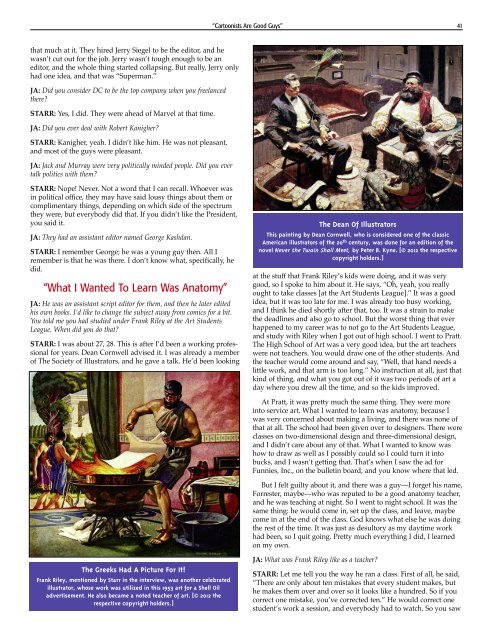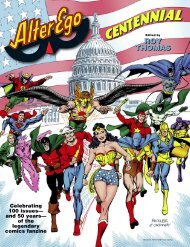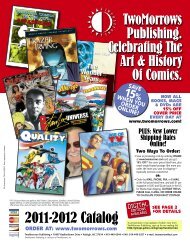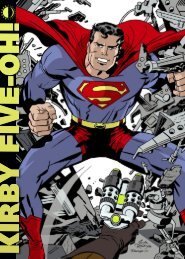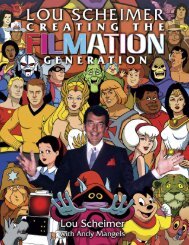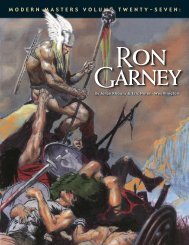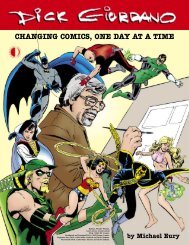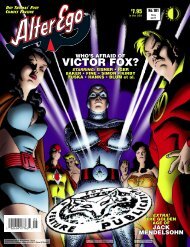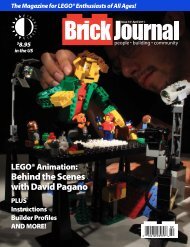50 Years Of Comic Book Fandom - TwoMorrows Publishing
50 Years Of Comic Book Fandom - TwoMorrows Publishing
50 Years Of Comic Book Fandom - TwoMorrows Publishing
You also want an ePaper? Increase the reach of your titles
YUMPU automatically turns print PDFs into web optimized ePapers that Google loves.
that much at it. They hired Jerry Siegel to be the editor, and he<br />
wasn’t cut out for the job. Jerry wasn’t tough enough to be an<br />
editor, and the whole thing started collapsing. But really, Jerry only<br />
had one idea, and that was “Superman.”<br />
JA: Did you consider DC to be the top company when you freelanced<br />
there?<br />
STARR: Yes, I did. They were ahead of Marvel at that time.<br />
JA: Did you ever deal with Robert Kanigher?<br />
STARR: Kanigher, yeah. I didn’t like him. He was not pleasant,<br />
and most of the guys were pleasant.<br />
JA: Jack and Murray were very politically minded people. Did you ever<br />
talk politics with them?<br />
STARR: Nope! Never. Not a word that I can recall. Whoever was<br />
in political office, they may have said lousy things about them or<br />
complimentary things, depending on which side of the spectrum<br />
they were, but everybody did that. If you didn’t like the President,<br />
you said it.<br />
JA: They had an assistant editor named George Kashdan.<br />
STARR: I remember George; he was a young guy then. All I<br />
remember is that he was there. I don’t know what, specifically, he<br />
did.<br />
“What I Wanted To Learn Was Anatomy”<br />
JA: He was an assistant script editor for them, and then he later edited<br />
his own books. I’d like to change the subject away from comics for a bit.<br />
You told me you had studied under Frank Riley at the Art Students<br />
League. When did you do that?<br />
STARR: I was about 27, 28. This is after I’d been a working professional<br />
for years. Dean Cornwell advised it. I was already a member<br />
of The Society of Illustrators, and he gave a talk. He’d been looking<br />
The Greeks Had A Picture For It!<br />
Frank Riley, mentioned by Starr in the interview, was another celebrated<br />
illustrator, whose work was utilized in this 1953 art for a Shell Oil<br />
advertisement. He also became a noted teacher of art. [© 2012 the<br />
respective copyright holders.]<br />
“Cartoonists Are Good Guys” 41<br />
The Dean <strong>Of</strong> Illustrators<br />
This painting by Dean Cornwell, who is considered one of the classic<br />
American illustrators of the 20 th century, was done for an edition of the<br />
novel Never the Twain Shall Meet, by Peter B. Kyne. [© 2012 the respective<br />
copyright holders.]<br />
at the stuff that Frank Riley’s kids were doing, and it was very<br />
good, so I spoke to him about it. He says, “Oh, yeah, you really<br />
ought to take classes [at the Art Students League].” It was a good<br />
idea, but it was too late for me. I was already too busy working,<br />
and I think he died shortly after that, too. It was a strain to make<br />
the deadlines and also go to school. But the worst thing that ever<br />
happened to my career was to not go to the Art Students League,<br />
and study with Riley when I got out of high school. I went to Pratt.<br />
The High School of Art was a very good idea, but the art teachers<br />
were not teachers. You would draw one of the other students. And<br />
the teacher would come around and say, “Well, that hand needs a<br />
little work, and that arm is too long.” No instruction at all, just that<br />
kind of thing, and what you got out of it was two periods of art a<br />
day where you drew all the time, and so the kids improved.<br />
At Pratt, it was pretty much the same thing. They were more<br />
into service art. What I wanted to learn was anatomy, because I<br />
was very concerned about making a living, and there was none of<br />
that at all. The school had been given over to designers. There were<br />
classes on two-dimensional design and three-dimensional design,<br />
and I didn’t care about any of that. What I wanted to know was<br />
how to draw as well as I possibly could so I could turn it into<br />
bucks, and I wasn’t getting that. That’s when I saw the ad for<br />
Funnies, Inc., on the bulletin board, and you know where that led.<br />
But I felt guilty about it, and there was a guy—I forget his name,<br />
Forrester, maybe—who was reputed to be a good anatomy teacher,<br />
and he was teaching at night. So I went to night school. It was the<br />
same thing: he would come in, set up the class, and leave, maybe<br />
come in at the end of the class. God knows what else he was doing<br />
the rest of the time. It was just as desultory as my daytime work<br />
had been, so I quit going. Pretty much everything I did, I learned<br />
on my own.<br />
JA: What was Frank Riley like as a teacher?<br />
STARR: Let me tell you the way he ran a class. First of all, he said,<br />
“There are only about ten mistakes that every student makes, but<br />
he makes them over and over so it looks like a hundred. So if you<br />
correct one mistake, you’ve corrected ten.” He would correct one<br />
student’s work a session, and everybody had to watch. So you saw


